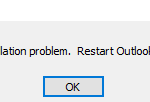This tutorial contains instructions to fix the following error in Microsoft Office Outlook “The Operation Failed due to a Registry or Installation problem. Restart Outlook and try again. If the problem persists, please reinstall.” (Outlook 2003, 2007, 2010, 2013, 2016).
The error described above, appears when you select the “New” button to write a new email message, or when you try to open the “Account” options from the “File” menu or when you click Rules -> Manage Rules & Alerts. Along with the above issue, you may receive the error “The operation failed”, when you try to press the “Data Files” button (in order to view the Outlook PST file), either from Outlook Options -> “Email Setup” tab, or from the “Mail” settings in control panel.

How to FIX: Outlook Operation Failed due to a Registry or Installation problem.
Step 1. Install Hotfix for Outlook 2013 or Outlook 2016.
If your are using Outlook 2013 or Outlook 2016,* then:
* Note: This step applies only to Outlook 2016 or Outlook 2013. If you ‘re using any other Outlook version, then continue to the next step.
1. Close Outlook.
2. Download and then install the following hotfix according your Outlook version:
- Outlook 2013 32Bit: https://www.microsoft.com/en-us/download/details.aspx?id=57670
- Outlook 2013 64Bit: https://www.microsoft.com/en-us/download/details.aspx?id=57671
- Outlook 2016 32Bit: https://www.microsoft.com/en-us/download/details.aspx?id=57667
- Outlook 2016 64Bit: https://www.microsoft.com/en-us/download/details.aspx?id=57668
3. Restart your computer.
4. Launch Outlook and check if the problem persists. (If the problem persists then continue to next step.)
Step 2. Repair Microsoft Office.
1. Navigate to Programs and Features. To do that:
1. Press simultaneously the Windows
+ R keys to open the run command box.
2. Type: appwiz.cpl and click OK.

2. In Programs and Features, select the Microsoft Office product that installed on your system and click Change (or click Repair if available).
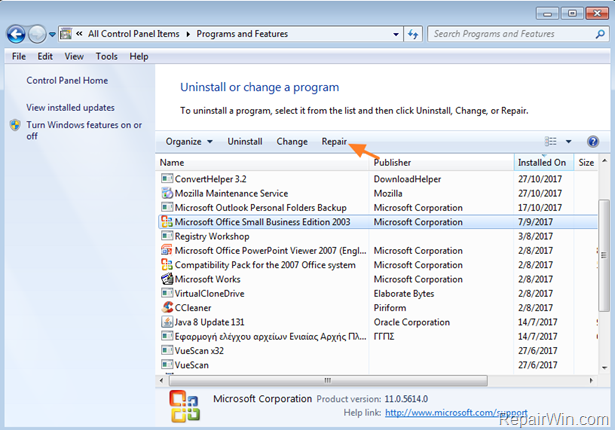
3. Finally click Repair and follow the rest steps to repair Microsoft Office.
4. After repair, check if the problem has resolved. If the problem persists then continue to next step.
Step 3. Delete and Re-Create Outlook Profile.
1. Navigate to Window Control Panel.
2. Change the View By: to Small icons.
3. Open Mail.
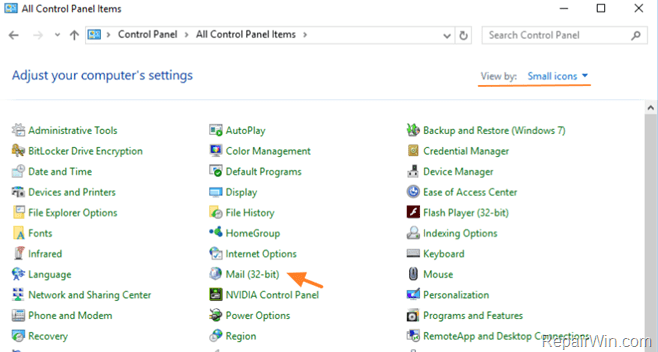
4. Click Show Profiles.
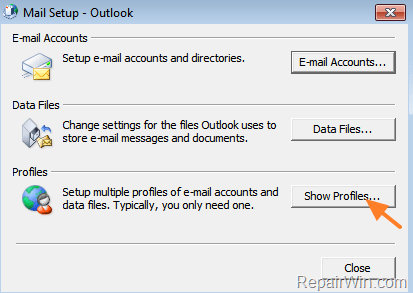
5. Click the Remove button to delete the current profile and click OK.
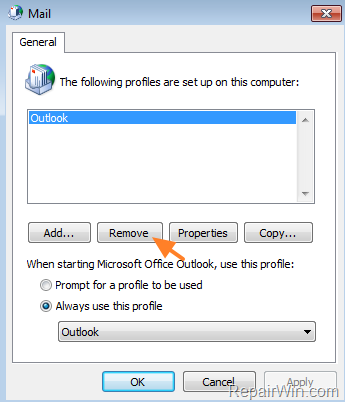
6. Launch Outlook and complete the required fields (Name, E-mail Address, Password, etc.) at Outlook “Add Account” to setup your Email account and to create a new Outlook empty profile.
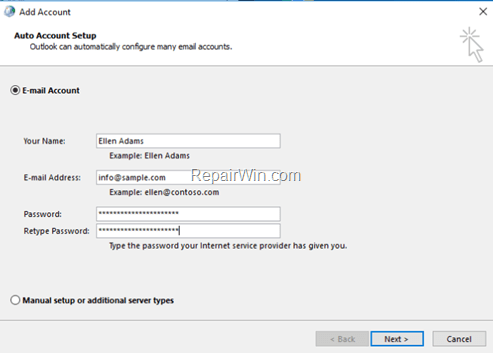
7. When done, proceed to Import* the old Outlook .PST data file (which contains your Outlook data) **, to the new profile, or set and use the old PST file, as the default location to store the Outlook data.
* To Import Outlook .PST file, follow the procedure below:
- Outlook 2016, 2013, 2010:
- Launch Outlook.
- Go to File > Open & Export > Import/Export.
- Select Import from Another Program or File & click Next.
- Select Outlook Data File (.pst) & click Next.
- Click Browse and navigate to the location of the PST file. **
- Select the Outlook PST file that you want to import & click Open.
- Click Next & Finish.
- Outlook 2007, 2003:
- Launch Outlook.
- Go to File > Import and Export.
- Select Import from Another Program or File & click Next.
- Select the Personal Folder File (.pst) & click Next.
- Click Browse and navigate to the location of the PST file. **
- Select the Outlook PST file that you want to import & click Open.
- Click Next & Finish
** Outlook .PST file location:
- Windows 10, 8, 7 or Vista:
C:Users<your username>AppDataLocalMicrosoftOutlookOutlook.pst - Windows XP:
C:Documents and Settings<your username>Local SettingsApplication DataMicrosoftOutlookOutlook.pst - Outlook 2016, Outlook 2013 & Outlook 2010:
C:Users%Username%DocumentsOutlook Files<Your_Email_Address>.pst
That’s all folks! Did it work for you?
Please leave a comment in the comment section below or even better: like and share this blog post in the social networks to help spread the word about this solution.

